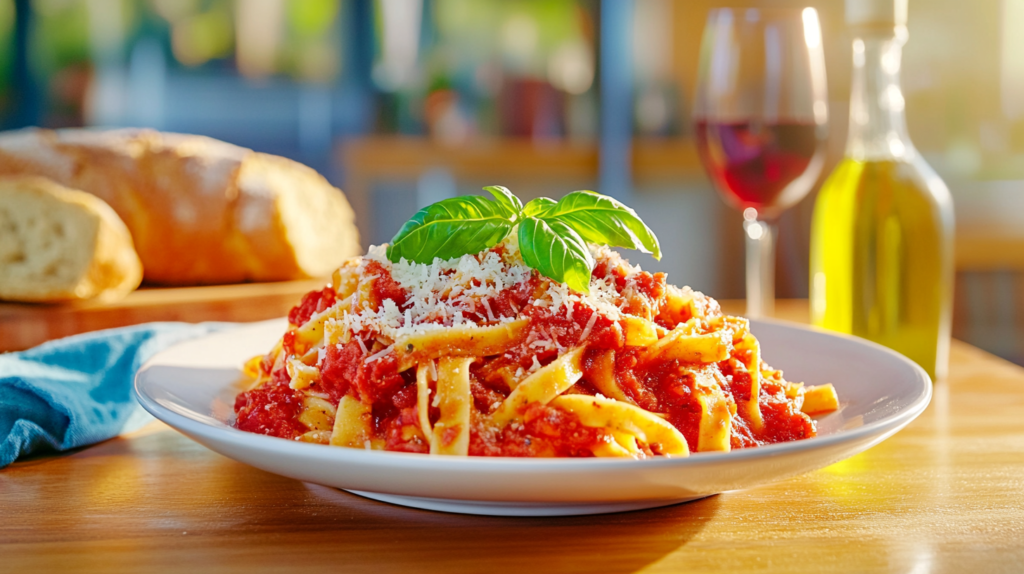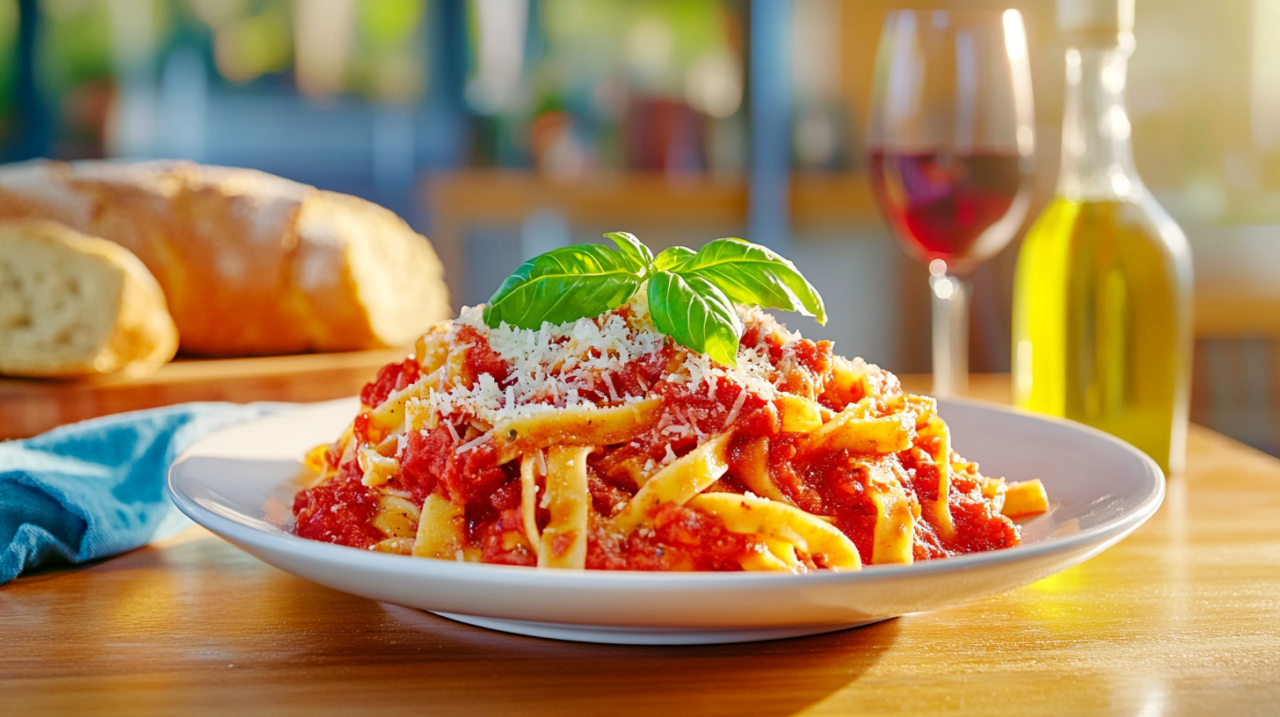
The Origins of Strozzapreti: A Historical Insight What does strozzapreti mean in Italian?
Strozzapreti, a unique type of pasta, has an intriguing history that connects food to culture. The name itself evokes curiosity, as its literal translation means “priest stranglers.” This unusual term originates from Italy’s colorful past, where folklore, tradition, and cuisine intertwine.
What does strozzapreti mean in Italian?
Historically, strozzapreti emerged in the Emilia-Romagna region, known for its rich culinary heritage. During the Middle Ages, pasta-making was both a domestic craft and a reflection of social dynamics. This dish likely arose in households where women prepared rustic, hand-rolled pasta to feed families economically.
The name strozzapreti carries a cultural story. Some legends suggest it referred to priests who were notorious for their appetite, often visiting homes and overindulging in meals. The pasta’s name humorously implied that its chewy texture might “strangle” a gluttonous priest! Others believe it symbolizes resistance to clerical greed, reflecting the locals’ playful critique of the clergy.
Regardless of the story’s truth, strozzapreti remains a testament to Italy’s culinary ingenuity, blending history with humor.
Strozzapreti and Its Meaning: Unraveling the Name What does strozzapreti mean in Italian?
So, what does strozzapreti mean in Italian? The direct translation is “priest stranglers,” a term that sparks both intrigue and amusement. But what lies behind this peculiar name?
The linguistic roots of “strozzapreti” derive from two Italian words: strozzare (to strangle) and preti (priests). This playful term likely developed as part of Italy’s rich storytelling culture, which often incorporates humor into daily life.
Several theories explain the pasta’s name. One tale suggests that the clergy, historically seen as gluttonous, would consume large amounts of food prepared by locals. The idea that this hearty pasta could metaphorically “choke” them was a tongue-in-cheek jab at their excessive appetites.
Another interpretation ties the name to the labor-intensive process of rolling and twisting the dough, a task so arduous that it might metaphorically “choke” the maker. Regardless of its origin, strozzapreti’s meaning reflects Italy’s tradition of combining satire, creativity, and culinary craft.
The Art of Making Strozzapreti: A Culinary Tradition
Check also : What is Strozzapreti? Discover the Origins, Making, and Perfect Pairings of This Italian Pasta
Creating strozzapreti is both an art and a testament to Italy’s culinary traditions. Unlike factory-made pasta, this type of pasta is handcrafted, requiring time, skill, and attention to detail.
Traditional Ingredients and Techniques What does strozzapreti mean in Italian?
The classic recipe for strozzapreti involves simple ingredients:
- Flour: All-purpose or semolina for a hearty texture.
- Water: Warm water to bind the dough.
- Salt: A pinch for flavor.
To make strozzapreti, the dough is kneaded until smooth, then rolled into thin sheets. Strips are cut and twisted by hand, creating a rustic shape. The twisting motion gives strozzapreti its characteristic ridges, ideal for holding sauces.
Modern Variations What does strozzapreti mean in Italian?
While the traditional recipe remains popular, modern chefs have introduced variations:
- Incorporating spinach or beetroot for color.
- Adding eggs for a richer dough.
- Experimenting with gluten-free flours for dietary needs.
Regional Differences
Each Italian region has its twist on strozzapreti. In Emilia-Romagna, it’s paired with ragù sauces, while in Tuscany, lighter condiments like olive oil and garlic enhance its flavors.
Making strozzapreti preserves a link to Italy’s past, offering a delicious way to connect with history.
Strozzapreti in Italian Cuisine What does strozzapreti mean in Italian?
Strozzapreti occupies a unique place in Italian cuisine, celebrated for its versatility and rich flavor profile. Its rustic shape and chewy texture make it a favorite in homes and restaurants alike.
Common Dishes Featuring Strozzapreti
- Ragù Strozzapreti: A hearty pairing with slow-cooked meat sauce.
- Pesto Strozzapreti: A vibrant option with fresh basil pesto.
- Seafood Strozzapreti: Combining clams, shrimp, and a light tomato broth.
Each dish highlights strozzapreti’s ability to complement diverse ingredients, making it a staple in Italian cooking.
Pairing Strozzapreti with Sauces
Due to its unique shape, strozzapreti excels at holding sauces. Thick sauces like bolognese or creamy alfredo cling to its ridges, ensuring every bite is flavorful. For a lighter meal, olive oil-based sauces with garlic and chili offer a refreshing contrast.
Cultural Significance
Beyond its taste, strozzapreti symbolizes Italian values: simplicity, family, and tradition. Preparing and sharing this pasta connects generations, honoring the country’s deep culinary heritage.
Whether enjoyed in a rustic Italian village or a modern kitchen, strozzapreti continues to charm food lovers worldwide.
Linguistic Breakdown of “Strozzapreti”
The term strozzapreti has intrigued many, and understanding its linguistic roots can reveal much about Italian culture and humor. In Italian, “strozzapreti” is a compound word, combining strozzare (to strangle) and preti (priests). This playful, yet somewhat cheeky name reflects both the physical properties of the pasta and a historical, cultural commentary.
The word strozzare refers to strangling, capturing the twisty, tight form that characterizes strozzapreti pasta. Meanwhile, preti is the word for priests, a group often associated with both influence and excessive consumption in historical Italian society. By merging these two terms, the name of the pasta evokes a sense of satire, humorously suggesting that the pasta’s dense texture might be difficult to swallow, much like a greedy priest indulging too much.
This linguistic blend reflects Italian culinary culture, where food names often carry layers of historical and cultural references.
The Cultural Context of Strozzapreti in Italy What does strozzapreti mean in Italian?
Strozzapreti is not just a food item; it carries deep cultural significance within Italy, connecting the country’s love of food with its rich history and social dynamics. Historically, pasta has been a symbol of Italian identity, and strozzapreti stands out because of its unique name and its relationship to Italian societal norms.
In many parts of Italy, pasta represents more than just nourishment; it symbolizes family, community, and tradition. The name “strozzapreti,” with its humorous twist, reflects the lively Italian attitude toward food—combining lightheartedness with respect for tradition.
It is also a reflection of regional humor, as Italians are known for using wit to critique authority figures. By naming a pasta after priests in a cheeky way, it highlights the long-standing role of food in commenting on and reflecting society.
Traditional Ingredients and Techniques
The creation of strozzapreti relies on a few simple yet vital ingredients. The traditional recipe is humble, reflecting the rustic roots of Italian home cooking.
Ingredients: What does strozzapreti mean in Italian?
- Flour: Usually all-purpose or semolina flour, providing the base for the dough.
- Water: To bind the flour and create a smooth, elastic dough.
- Salt: For seasoning, enhancing the overall flavor.
To make strozzapreti, you knead the dough by hand until it becomes smooth and elastic. Then, roll the dough into thin sheets and cut it into strips. Afterward, twist the strips to create the pasta’s characteristic shape.
Traditional Techniques: What does strozzapreti mean in Italian?
- Hand-rolling: The pasta is often rolled by hand, adding to the rustic and homemade feel of the dish.
- Twisting the dough: After cutting, the strips are twisted by hand, which gives the pasta its unique, elongated shape.
This method of handcrafting pasta ensures that each piece of strozzapreti carries both tradition and attention to detail, making it a truly special dish in Italian cuisine.
Modern Variations of Strozzapreti Recipes
While many Italian homes still cherish traditional strozzapreti, contemporary chefs and home cooks have found creative ways to modernize the dish. Variations now incorporate new flavors, textures, and even cater to modern dietary preferences.
Variations of Ingredients:
- Gluten-free Options: For those with gluten sensitivities, modern recipes may substitute traditional flour with gluten-free alternatives such as rice flour or chickpea flour.
- Vegetable Additions: Some recipes add spinach, beetroot, or pumpkin to the dough, infusing the pasta with vibrant colors and additional nutrients.
Creative Sauces and Pairings:
- Pesto Strozzapreti: A fresh, flavorful pesto made from basil, garlic, and pine nuts complements the pasta beautifully.
- Seafood Variations: Modern takes include pairing strozzapreti with shrimp, clams, or a variety of seafood in a light tomato sauce.
These modern variations maintain the integrity of the original dish while adding contemporary twists that make strozzapreti accessible and appealing to a broader audience.
Regional Differences in Strozzapreti Preparation
Strozzapreti’s preparation can vary greatly across Italy, with different regions putting their unique spin on the dish. These regional differences reflect Italy’s diverse culinary landscape and the local ingredients available.
Emilia-Romagna:
Known as the birthplace of strozzapreti, this region typically pairs the pasta with rich meat sauces like ragù. The sauce clings beautifully to the twisted pasta, creating a satisfying and hearty meal.
Tuscany:
In Tuscany, strozzapreti is often prepared in a simpler manner, served with olive oil, garlic, and a sprinkle of fresh herbs. This allows the flavor of the pasta itself to shine through.
Lazio:
In the Lazio region, strozzapreti is often paired with lighter sauces, such as tomato and basil, or simply drizzled with extra virgin olive oil and a dash of chili flakes for added spice.
Each region’s version of strozzapreti reflects local tastes, preferences, and the abundance of fresh, seasonal ingredients, making the pasta a versatile dish that adapts to its surroundings.
Common Dishes Featuring Strozzapreti What does strozzapreti mean in Italian?
Strozzapreti is a highly versatile pasta, frequently featured in Italian cuisine in a variety of different dishes. Its unique shape makes it an ideal match for both hearty sauces and lighter toppings, creating a balance of textures and flavors.
1. Strozzapreti with Ragù
The rich, meaty ragù sauce is a classic pairing for strozzapreti. The sauce, often made from slow-cooked beef, pork, or a combination of meats, adheres to the pasta’s ridges, making each bite full of flavor.
2. Strozzapreti with Pesto
A fresh basil pesto made with olive oil, garlic, and pine nuts is another favorite topping. The herbaceous, garlicky flavors of the pesto complement the pasta’s chewy texture, creating a light yet satisfying dish.
3. Seafood Strozzapreti
In coastal regions of Italy, strozzapreti is commonly served with fresh seafood. Shrimp, clams, or mussels are cooked with garlic and tomatoes, then served over the pasta for a flavorful and indulgent dish.
4. Vegetable Strozzapreti
For a lighter, vegetarian option, strozzapreti can be paired with a medley of roasted vegetables, such as zucchini, peppers, and eggplant, creating a colorful and healthy dish.
These dishes showcase the versatility of strozzapreti, proving that this pasta can be adapted to suit any palate or occasion.

